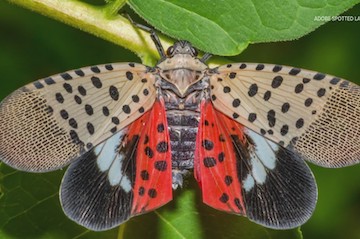
10/08/2024
Scientists encourage people to let most colorful insects, like the monarch butterfly, flit and flutter in peace.
But some they want you to squash on sight.
That’s the case with the invasive spotted lanternfly, a brilliantly hued leafhopper that has rapidly spread since arriving 10 years ago and now threatens grape and apple crops in New York’s Finger Lakes region in areas near Cortland.
Of course, before you can swat a lanternfly it has to be, well, spotted.
To that end, SUNY Cortland’s Sustainability Office has joined a regional early-warning effort to detect the arrival of the winged threat one bug at a time. The university this summer partnered with the Finger Lakes Partnership for Regional Invasive Species Management (PRISM) at Hobart and William Smith Colleges’ Finger Lakes Institute to host a trap on campus.
PRISM is the primary organization dedicated to preventing the spread of invasive species within the greater Finger Lakes region and is leading the trapping initiative. Cortland’s trap is one of more than 150 scattered throughout the region as part of one of the largest networks of spotted lanternfly traps in New York state.
“After working and living in the Finger Lakes, I know the damage invasive species can cause to an ecosystem,” said Megan Swing, SUNY Cortland’s energy and sustainability engagement coordinator. “I am excited to have SUNY Cortland take part in the effort to protect valuable agricultural resources for decades to come.”
The trap is an awkward-looking contraption of wood, mesh and plastic hung on a tree between the Professional Studies Building and the Student Life Center, by the commuter parking lot. The placement was intentional as PRISM has stated that the primary method that SLF uses to spread is by hitching rides on vehicles.
So far, no spotted lanternflies have been seen in Cortland.
But Swing and SUNY Cortland Energy Manager and Campus Sustainability Coalition Chair Matt Brubaker are staying vigilant, checking the trap biweekly and reporting their findings to PRISM.
“The spotted lanternfly has now firmly established itself in the heart of the Finger Lakes Wine Country, and is likely going to spread,” said Matt Gallo, PRISM terrestrial invasive species coordinator. “Early detection of these new infestations is one of our best tools to slow the spread.”
Although Swing and Brubaker urge all students, faculty and staff to be alert for spotted lanternflies, they urge people to leave the trap alone. PRISM asks anyone who thinks they see the pest to take a picture of the insect and send that photo to spottedlanternfly@agriculture.ny.gov.
The spotted lanternfly was first detected in the United States near Philadelphia in 2014, likely arriving on a cargo shipment. Since its arrival, it has rapidly spread across Pennsylvania and along the east coast, eventually arriving in New York state and the Finger Lakes region in 2020.
A population was found in Romulus, N.Y. a village about an hour west of Cortland, in July.
For more information on the PRISM program, visit its website. Individuals interested in becoming more involved in the program should contact the Sustainability Office.